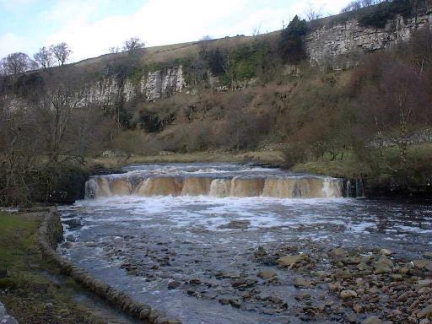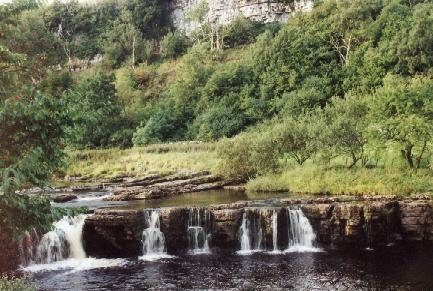
Keldside lead smelt mill in Swaledale.
When this picture was taken, Keldside lead smelt mill was being used as a farm building.
N.B. Narrative and pictures are as of the times when the pictures were originally added (mostly 1997 to
2004). In 2021, things may look different; conditions, tracks and rights of way may have changed.
Click on the Home button for more explanation.
Getting to Keldside Lead Smelt Mill.
Keldside lead smelter (smelt mill) is only a few yards from the B6270 road. Follow the B6270
which is the main road through Swaledale from Keld. After about 1 mile, you will see the
former smelt mill and its peat store on the left. The mill is clearly distinguished by its pair of
stone arched windows which may have helped this particular wall to withstand the ravages of
time. Clearly, the rotting and failure of wooden lintels can accelerate the collapse of walls.
Keldside Smelt Mill was probably the only one of the many old smelters in the Dales which still
had a real use at the turn of the millenium. For much of the building's length, only its front wall still
exists. The east end is roofed with slate and is used as an agricultural building. The remainder has
been made also into an agricultural building also, but by use of corrugated metal sheeting erected at
the rear.
Three internal flues join into one external flue behind the smelter. The single flue carried the fumes
from the smelter up Keld Side to a square chimney, which is now about 10 feet high.
We understand that there was once a water wheel which worked the
bellows. There is no longer any lead industry water wheel left at any
of the Dales' smelt mills. At Keldside, there is not even any obvious
trace of the water course and the tail race which once carried the
spent water to the Swale below.
By climbing Keld Side, the hill behind (i.e. to the South of) Keldside
Mill, we found the remains of the chimney.
An Ah But! statement: The mill probably started up about 1839, making it one of the latecomers.
The mines in the vicinity had been trying to access "wet" levels where the ore was below the level
of the nearby Swale. The trials had shown that the lower levels of the veins contained good ore
deposits, but water could not be controlled. According to Arthur Raistrick, steam pumps once
promised success where water wheel driven pumps had not been able to cope. Apparently though,
water remained a problem. Possibly, the
building of the mill had been premature and
it did not become a great lead producer. We
understand that in attempt to dry the lower
strata in the area, a start was made at Keld,
to get direct drainage through a planned
mile long tunnel. The outlet at Keld would
be much lower down the valley than many
of the 'wet' mines. The outlet at Keld would
have been low enough to drain the mines without pumping. Apparently, work on the tunnel was
abandoned as difficulties made it far more expensive
than had been anticipated. The smelter did find work
as there were still a few 'dry' levels in the vicinty,
such as those in the Sir George Mines. When the dry
levels were exhausted, the lower 'wet' levels
remained unexploited and the Keldside Mill closed.
The smelt mill's tail race met the Swale at a particularly pretty place, near Wain Wath Force shown
below, left, when the Swale was 'quiet.' Cottersby Scar is in the background. Below, right, is Barry
Jones’s picture of the falls in full spate.
Link to the page on the
Marrick Smelt Mill >>>




John looking uphill from the back of the smelt mill.



When this picture was taken, Keldside lead
smelt mill was being used as a farm building.
N.B. Narrative and pictures are as of the times when
the pictures were originally added (mostly 1997 to
2004). In 2021, things may look different; conditions,
tracks and rights of way may have changed.
Click on the Home button for more explanation.
How to get there.
Keldside lead smelter (smelt mill) is only a
few yards from the B6270 road. Follow the
B6270 which is the main road through
Swaledale from Keld. After about 1 mile, you
will see the former smelt mill and its peat
store on the left. The mill is clearly
distinguished by its pair of stone arched
windows which may have helped this
particular wall to withstand the ravages of
time. Clearly, the rotting and failure of
wooden lintels can accelerate the collapse of
walls.
Keldside Smelt Mill was probably the only one
of the many old smelt mill buidings in the Dales
which still had a real use at the turn of the
millenium. For much of the building's length,
only its front wall still exists. The east end is
roofed with slate and is used as an agricultural
building. The remainder has been made also into
an agricultural building also, but by use of
corrugated metal sheeting erected at the rear.
Three internal flues join into one external flue
behind the smelter. The single flue carried the
fumes from the smelter up Keld Side to a square
chimney, which is now about 10 feet high.
We understand that there was once a water
wheel which worked the bellows. There is no
longer any lead industry water wheel left at any
of the Dales' smelt mills. At Keldside, there is
not even any obvious trace of the water course
and the tail race which once carried the spent
water to the Swale below.
By climbing Keld
Side, the hill
behind (i.e. to the
South of)
Keldside Mill, we
found the remains
of the chimney.
An Ah But! statement: The mill probably started
up about 1839, making it one of the latecomers.
The mines in the vicinity had been trying to
access "wet" levels where the ore was below the
level of the nearby Swale. The trials had shown
that the lower levels of the veins contained good
ore deposits, but water could not be controlled.
According to Arthur Raistrick, steam pumps
once promised success where water wheel
driven pumps had not been able to cope.
Apparently though, water remained a problem.
Possibly, the building of the mill had been
premature and it did not become a great lead
producer. We understand that in attempt to dry
the lower strata in the area, a start was made at
Keld, to get direct drainage through a planned
mile long tunnel. The outlet at Keld would be
much lower down the valley than many of the
wet' mines. The outlet at Keld would have low
enough to drain the mines without pumping.
Apparently, work on the tunnel was abandoned
as difficulties made it far more expensive than
had been anticipated. The smelter did find work
as there were still a few 'dry' levels in the
vicinty, such as those in the Sir George Mines.
When the dry levels were exhausted, the lower
'wet' levels remained unexploited and the
Keldside Mill closed.
The peat store and smelt mill seen from the
"rear”. John looking uphill from the back of the
John looking uphill from the back of the smelt
mill. The River Swale can just be seen beyond
the road.
The smelt mill's tail race met the Swale at a
particularly pretty place, near Wain Wath Force
shown below when the Swale was 'quiet'.
Cottersby Scar is in the background.
To complete this webpage, a picture by Barry
Jones taken when the falls were in full spate.
Link to the page
on the Marrick Smelt Mill >>>
Keldside lead smelt mill
in Swaledale.


















